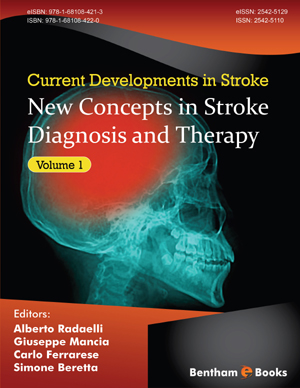Abstract
The penumbra is an area of living brain tissue immediately surrounding the necrotic core of an ischemic or thrombolytic stroke. The penumbra may remain viable several hours post-stroke due to blood flow from collateral arteries. Thus, this area of peri-infarct tissue is a therapeutic target for post- stroke and neuroprotective treatment modalities. Due to the fact that the ratio of viable to non-viable tissue decreases with time, Factor Xa and Factor II inhibitors such as enoxaparin and thrombolytics such as recombinant tissue plasminogen activator (r-tPA) must be administered immediately for optimal, synergistic treatment outcomes. The Broderick Lab is the first to study penumbral brain neurochemistry after causal acute ischemic stroke (AIS) by middle cerebral artery occlusion (MCAO) in vivo, as well as to comprehend the effects of enoxaparin (Lovenox®) and reperfusion via in vivo biochip nanotheranostics actually imaging the penumbra and its surrounding tissue intravascularly. Indeed, using Neuromolecular Imaging (NMI) with BRODERICK PROBE® nanobiosensors, animals were studied as their own control and each side of the brain was imaged in vivo, online, and in real time. NMI is a technology that uniquely images the baseline state of subjects before a disease state occurs, thereby establishing an intra-subject control model. In the same subject, with no gliosis, both the infarcted and peri-infarcted regions were imaged before, during, and after enoxaparin administration. Such imaging is available only with NMI nanobiosensor technology. In fact, with this new NMI nanobiosensor technology, the specificity of comparing baselines during drug and disease states is high because of the ability of NMI to compare baselines in thousands of previous studies of prescient and non-prescient mammals in vivo. Concurrently, Dual Laser Doppler Flowmetry (DLDF) was used to monitor cerebral blood perfusion. The results of this study demonstrate that, using intra-subject studies online (a) NMI profiles for dorsal striatum in basal ganglia are baseline values, ipsilaterally and contralaterally. (b) Diminished cerebral blood perfusion from AIS produces a significant increase of DA and 5-HT neurotransmitter concentrations, as well as associated metabolites and precursors, in motor neurons. (c) Enoxaparin alleviates oxygen deficiency by enhancing blood perfusion and reduces DA-induced brain trauma, enabling brain repair and regeneration. (d) Enoxaparin increases 5-HT release from motor neurons within the ipsilateral, lesioned hemisphere, as well as in the contralateral, non-lesioned hemisphere, particularly during the reperfusion stage. This serotonergic effect demonstrates the potential use of enoxaparin as an antidepressant, which would be clinically relevant for treating the depression that oftentimes is comorbid with AIS. (e) The area of post-stroke infarcts is significantly reduced upon reperfusion; and (f) Cerebral blood perfusion is augmented in a compensatory manner by both enoxaparin therapy and reperfusion within both hemispheres, particularly the contralateral hemisphere. Thus, this research demonstrates the efficacy of enoxaparin in preserving the viability of the penumbra in stroke victims and supports consideration of the combined use of enoxaparin with r-TPA in standard stroke treatment protocols in order to harness the brain’s intrinsic repair system. Moreover, these studies demonstrate the power of NMI nanotechnology in conjunction with BRODERICK PROBE® theranostic nanobiosensors to reliably study the intricacies of stroke in order to develop further neuroprotective treatments and allow personalized medicine to be realized.
Keywords: Anti-platelet, Brain attack, Brain repair, Cerebral blood perfusion, Enoxaparin, Imaging, Infarct, Intravascular, Ischemia, Lovenox®, Microcirculation, Nanobiosensors, Nanodiagnostics, Nanotheranostics, Nanotherapeutics, Neuromolecular Imaging, Occlusion, Peri-infarct, Personalized medicine, Point of care, Reperfusion, Sensors, Stroke, Surgery, Theranostics, thrombolytic, Tissue imaging.






















